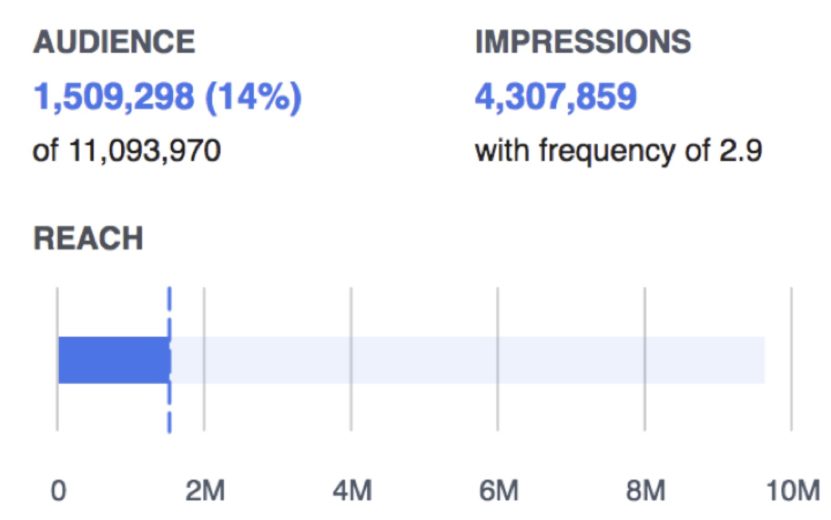5 Steps To Master Facebook Projections NOT Predictions

“Tell me how much I should spend in Facebook and what results I can expect.”
This sentence is one we hear frequently from our clients. I used to cringe every time I heard this sentence. When I would hear it the over-analytical side of me would take over and freak-out because A.) I knew the volatility of Facebook’s ever-changing platform, varying audiences, and fewer metrics being available and B.) Most importantly, I was terrified of being held to a “prediction”!
After many talks with a pretty smart guy and a few rounds of breathing into a paper bag, I came to realize I was making this way more stressful and difficult than I needed to. The problem was I was hung up on the “prediction” and being 100% accurate. It’s my nature, and many of my colleague’s, to always strive for perfection when sometimes all clients want is just a simple projection to get started and perfection can come later.
Below, I will cover how I broke down and simplified Facebook projections in 5 easy steps.
- Expectations
- Goals
- Tools
- The Projections NOT Predictions
- Measure and Adjust
Expectations
- Facebook is typically high funnel traffic
- Do not expect Facebook to perform similar to Google or Bing low funnel campaigns
Let’s just get that out there right away. Facebook has different metrics, different audiences, and is typically more top of funnel compared to Google and Bing search campaigns.
Are we setting up a brand new test or looking for projections based on historical performance in Facebook?
If it is a brand new test, there should be buy-in and agreement that this is a test with a set budget and time frame to evaluate performance. Quick, rash decisions can harm the results of the test and not allow for enough data to see long-term gains. You could miss out on big wins by not allowing enough time to gather data from the test or being under the impression Facebook will perform similar to AdWords or Bing search campaigns.
Goals
As I mentioned above, Facebook does not always perform similar to Google and Bing search campaigns. Therefore, you should not have the same goals. If you have historical data from previous campaigns that you’ve ran, you may be able to more easily back out numbers to set hard conversion goals. Or, if you do not have any historical conversion data to pull from, maybe you decide to set goals focused more on engagement and key learnings for further testing.
Example: Brand new Facebook campaign
Goal: Run a test for 30 days with a budget of X to gather key learnings to set more concrete CPA or ROAS goals. During this time our main KPI will be engagement metrics – Likes, shares, link clicks, CTR, ect.
If you have a break-even goal that you know you must reach, you can set those goals in place to have everyone on the same page and ensure profitability.
At the end of a test it should also be a goal to evaluate attribution across all channels. How did this test impact other channels? Was there a lift in total conversions/ revenue that could be attributed to this test?
The bottom line is to set goals. Get agreement from everyone and the evaluate results.
Tools
Now that you’ve set expectations and goals, next we will cover what tools can be helpful for creating Facebook projections. A couple tools I find helpful for getting started with projections are:
Facebook Campaign Planner is a great resource for branding campaigns to provide estimated audience size and costs. However, the campaign planner and Facebook are a living beast so the numbers do change frequently and become outdated so it’s important to refresh your numbers. For this reason, providing Facebook projections can be tricky.
The Projections NOT Predictions
Let’s take a look at how this scenario would break down. In this example, let’s say the client that wants to test Facebook as a brand new channel and has no idea where to start.
1.) Start with the 70/20/10 rule. Let’s use 10% of the client’s $100,000 monthly PPC budget to test Facebook for 1 month = $10,000. While it’s not an exact science, we’ve found this figure to be a pretty accurate place to start after reviewing budgets over a wide range of clients.

Once you have an estimated budget of what you’d like to test you can build out your audience targets in the campaign planner.

The campaign planner spits out the metrics you need to back out your estimated conversion numbers.
To project estimated conversions you will need to figure out what the best Conv/Impression CVR. Typically CVR should stay fairly consistent if it’s going to the same landing page. However, CVR will vary from Remarketing vs. prospecting, so keep that in mind depending on how granular you would like to get with your projections.
If you’ve never run a Facebook Ads campaign before and not sure what the conversion/impression CVR should be, you could potentially use the conversion/impression CVR you are getting for Google Display or similar audiences as a baseline. Or, if you have access to other industry data in Facebook you could use those numbers as an estimate as well. For example, on average across several ecommerce accounts in Facebook, we are seeing .16% conversion/impression CVR and for Lead Gen .03%*.
*These are general estimates numbers will vary.
So for this example, let’s say your account averages a conversion/impression CVR of .16%. Now that you have that number you can do the math to back out the conversions and CPA.
Est. Conversions = Est. Impressions * Conversion/Impressions

Measure And Adjust
Now you have outlined the details of the test and have agreement from everyone involved. You have some estimated baseline projections to get started. Next, it’s time to let the agreed about test run for the set time period, optimize and evaluate.
Once you have actual hard conversion data from your test, you’ll be able to provide more accurate projections moving forward. You’ll also be able to have audience insight takeaways beyond the conversion numbers. For example, demographic insights, attribution, interests, and other information to help you understand your target persona. From there you can use this data for other tests and even other channels.
Good luck and happy testing!



